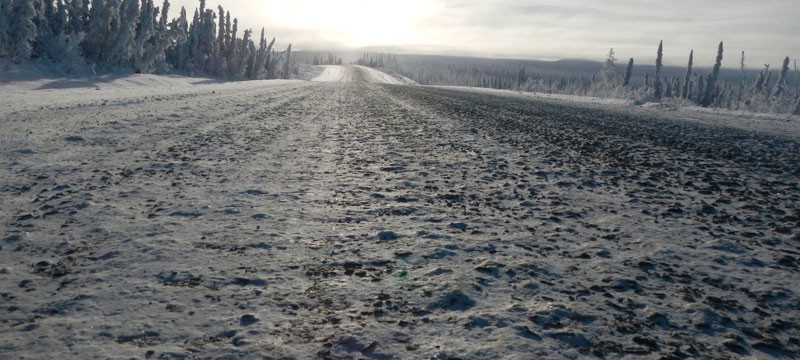This essay first appeared as a audio episode on World Ocean Radio. Peter Neill is host and author.
Roads and the Future of the Arctic

The Arctic is distant and impenetrable. Its place in the world, like its sister pole to the South, is to be apart. The people who, uniquely, inhabit the north have long lived within parameters of separation, from a world history that has unfolded manically below them, a stasis frozen in time and indifferent to the noise of civilization. In that vast silence, over centuries, they have adapted and devised a wisdom of how to live in harsh places. Theirs in an inner-directed society, based on survival; with animals enduring there alongside, providing, through perseverance and good hunting, food, water, energy, clothing, medicine, and other materials by which to shelter and thrive.
A 2017 report on transportation prepared by the Inuit Circumpolar Council of Canada is entitled The Sea is our Highway and argues unequivocally “that life in the Arctic is dependent on movement,” freedom that enables inhabitants to move and exploit the richness to sustain generations. No one can argue that it was, and remains, nothing but a hard life, but it was their life celebrated by achievement and rich cultural traditions passed through generations. In essence, the sea ice was the first Arctic road down which this history traveled.
The larger world found the place apart nonetheless — the arrival of explorers and scientists who appropriated their findings for themselves in the form of knowledge exported to the lecture halls and natural history museum of Europe and the United States. These were followed by the exploiters, looking for wealth as gold or oil or fish, indifferent to social consequence in the intruded places.
The 1974 construction of the Alaskan Dalton Highway that connected the oil fields of the Arctic to the processing and consuming machines to the south was a transformative moment. The engineering perseverance of building such a link across such a vast and unwelcoming landscape was well-compensated by the facility that followed: tanker trucks, and pipelines, that descended from the north to the big consuming engine to the south, crossing and disrupting habitats, animal migration routes, and the stability of indigenous society. As with the Caribbean and Africa, these were de facto connections of colonization, designed to take away the spoils while bringing new values, co-opted governance, disease, drugs, alcohol, marginalization, broken communities, and disrupted traditions. All in all, this second road seems in retrospect much like a one-way street.
This year, a third road was completed by virtue of a 128-kilometer extension between Inuvik, an administration hub and largest town in Canada’s Western Arctic, that reaches Tuktoyaktuk, a small village of 900 on the shore of the Bering Sea. But this one is perhaps different. According to Cyropolitics, a very informative series of blog entries by Mia Bennett, an author and dedicated Arctic observer, that through her conversations with the residents of these towns, “it became clear that the Inuvik-Tuktoyaktuk Highway is, at its heart, a local project. The new link… is a result of years of tireless, strategic lobby by members of the Inuvailuit community, one of the indigenous peoples living on the lands that the highway cuts across.” Bennett suggests, “their project was really about building a road between two communities in order to provide much-needed jobs, stimulate economic activity, and hopefully lower the prices of things like groceries and fuel.” The distinction here is that, while the funds and intentions might be defined by distant government aspirations, the actual road was supported, built, and used for the benefit of the people who actually live in the region.
But here’s a cautionary note: with the possibility, yet again, of permitting oil drilling in the Arctic Ocean, we are faced with these constructs as “roads to resources” and all the good — and bad — that has been shown to entail.
The saddest aspect of this story of Arctic roads is the present day rapid melting of the sea ice, the first road that connects across the Arctic in multiple directions and multi-layered dimensions of meaning. No matter the success of roads two and three, if the first road is gone, how much will be lost, and how can those people survive in a place now again apart?
- Login to post comments
-


